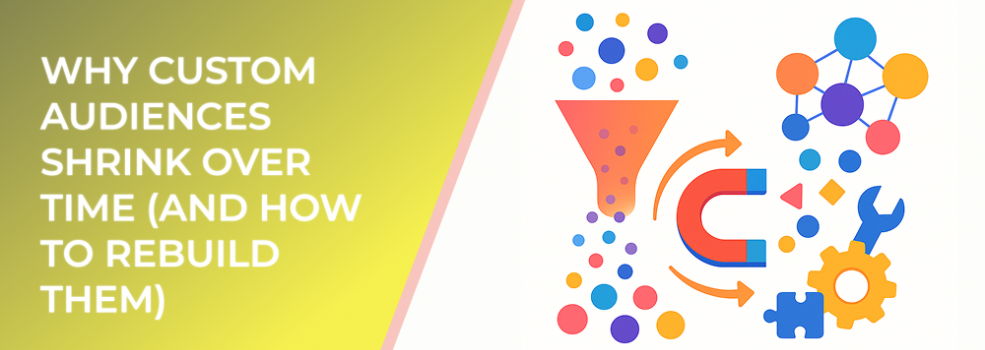If you rely on custom audiences for targeting, retargeting, or lookalikes, you’ve probably noticed a steady decline in size and reach over time. This isn’t just seasonality—it’s structural. Below we break down why custom audiences contract and give you a step‑by‑step rebuild plan you can run with LeadEnforce.
Why Custom Audiences Shrink
1) Natural data decay
People change jobs, emails, phone numbers, and devices. Dormant contacts bounce, churn, or unsubscribe.
-
Common benchmark: permissioned contact lists often decay ~20–30% per year, with higher decay in B2B and high-churn consumer categories.
-
Weekly drift: even stable lists can lose 0.5–1% of reachable identifiers per week if not replenished.
2) Privacy headwinds and signal loss
Platform and OS changes reduce the identifiers available for matching and remarketing.
-
Mobile tracking opt-outs: large shares of users now limit cross‑app tracking, which depresses match rates and retargeting pools.
-
Cookie deprecation: browser changes reduce third‑party cookies, shrinking web‑based remarketing audiences.
3) Match-rate friction
Your audience file may be valid—but the platform can’t match it reliably.
-
Fragmented identifiers: one user might appear as work email, personal email, and two phone numbers. If you upload only one, you miss matches.
-
Hashing & formatting errors: small formatting issues (country codes, whitespace, casing) can reduce match rates by 10–25%.
-
Single‑source seeds: relying on one source (e.g., just website emails) limits total matches compared to multi‑identifier seeds.
4) Suppressions and policy filters
Platforms automatically remove people for policy reasons (e.g., age, region, sensitive categories) and you’ll also suppress recent converters or unsubscribers. Healthy—but it shrinks active pools.
5) Frequency saturation
High frequency with limited creative variety pushes users to fatigue faster. Over time, reach falls in your fixed audience even if the raw size looks similar.
6) Organizational drag
Lists get siloed across teams and tools; refresh processes are manual; owners change. Without a clear owner and cadence, audiences atrophy.
Key Numbers to Track (and Improve)
-
Upload → Match Rate: target 60–80%+ on consumer files; B2B often lower. Track by identifier (email vs. phone vs. MAID).
-
Net Audience Delta (weekly): (Adds – Removals – Decay). Aim for positive net growth every week.
-
Recency Mix: percent of audience added in last 30/60/90 days. A healthy pool has 40–60% added in last 60 days.
-
Frequency & Freshness: keep average frequency < 6–8 / 7 days on prospecting; lower for small remarketing pools.
The Rebuild Playbook (LeadEnforce‑Ready)
Step 1 — Diagnose
-
Baseline match rates for each identifier type you upload (email, phone, MAID). Note formatting/hashing practices.
-
Segment by recency (0–30 / 31–60 / 61–90 / 90+ days) to see where shrinkage starts.
-
Map sources (CRM, checkout, loyalty, webforms, events). Identify gaps and silos.
Step 2 — Restore Signal
-
Multi‑identifier enrichment: where consent allows, pair emails with phone numbers and names for better matching.
-
Standardize formatting: normalize country codes, casing, and punctuation; hash consistently.
-
Close the loop: capture opt‑in identifiers at every touchpoint (post‑purchase, gated content, lead forms, offline events).
Step 3 — Automate Refresh
-
Set a 7‑day refresh cadence for high‑velocity sources; monthly for slow sources.
-
Use dynamic windows (e.g., “active in last 90 days”) rather than static files.
-
Schedule uploads/syncs so your audiences never go stale.
Step 4 — Rebuild Scale Without Waste
-
Stack sources (CRM + web leads + loyalty + event scans) into one master seed, then deduplicate.
-
Spin up lookalikes from your freshest, highest‑value cohorts (e.g., 0–30 day buyers, high LTV segments).
-
Apply smart exclusions (recent buyers, refunders) to protect budget while you scale.
Step 5 — Protect Performance
-
Rotate creatives and cap frequency to avoid burnout.
-
Split test match‑rate improvements (e.g., email‑only vs. email+phone) and keep the winner.
-
Watch the net delta weekly; if it turns negative for two weeks, revisit sources and recency windows.
How LeadEnforce Helps
-
Unified audience building: combine multiple sources and identifiers in one place, then export or sync to major ad platforms.
-
Automated refresh schedules: keep audiences current with hands‑off, recurring updates.
-
Data hygiene & deduplication: reduce formatting mistakes that crush match rates.
-
Consent‑first growth: capture and manage permissioned identifiers; segment by recency to feed high‑quality lookalikes.
-
Actionable diagnostics: monitor size, match‑rate trends, recency mix, and net delta to catch shrinkage early.
30/60/90‑Day Implementation Plan
Days 0–30: Foundations
-
Audit sources, identifiers, and hashing/formatting.
-
Normalize data and set initial weekly refreshes.
-
Build master seed from the last 90 days; dedupe; baseline match rates.
Days 31–60: Acceleration
-
Add phone numbers/secondary emails where consented.
-
Launch 1–2 lookalikes from 0–30 day converters.
-
Add exclusions and start creative rotation + frequency caps.
Days 61–90: Scale & Sustain
-
Expand sources (events, loyalty, offline).
-
Move to 7‑day refresh for fast sources; monthly for slow.
-
Install weekly KPI review: match rate, recency mix, net delta.
Troubleshooting Guide
-
Match rate < 40%: check formatting (country codes, spaces), add identifiers, and validate hashing consistency.
-
Audience growth stalls: widen recency window (e.g., 60 → 90 days), add new sources, and confirm refresh schedule ran.
-
Costs rise / ROAS falls: tighten exclusions, lower frequency caps, refresh creatives, and rebuild lookalikes off fresher cohorts.
-
Remarketing too tiny: add more capture points on site (consented email/phone), expand page‑view events, and include cart‑initiators.
KPI Checklist (copy/paste)
-
Upload → match rate by identifier ≥ target
-
Net audience delta positive
-
40–60% of audience added in last 60 days
-
Frequency within caps
-
Lookalikes fed by high‑value, recent cohorts
-
Refresh jobs green (last run < 7 days)
Suggested Reads from the LeadEnforce Blog
-
Facebook Ad Copywriting: How to Match Tone With Buyer Intent
-
How to Fix Uneven Spend Distribution Across Facebook Ad Sets
-
When to Rebuild Facebook Audiences That Have Stopped Performing
Takeaway
Custom audiences shrink because data ages, signals fade, and match‑rate frictions add up. The fix isn’t one silver bullet—it’s a system: multi‑identifier seeds, consent‑first capture, automated refresh, smart exclusions, and continuous diagnostics. With LeadEnforce, the mechanics (building, deduping, refreshing, and monitoring) are streamlined so your team can focus on growth, not file wrangling.

